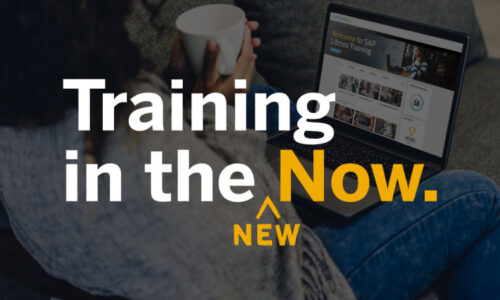Training in the New Now
Suffice it to say, it’s been an odd year. From March 11, 2020 to March 11, 2021 much has changed. And, while some things may “return to normal,” many things will not. People have a heightened sense of concern about contracting airborne or other contagious diseases. Physical closeness with others (whether strangers, coworkers, and even friends and family) may have taken a permanent hit as we’ve grown accustomed to mask-wearing and social distancing. People may now be prone to worry (if not outright suspicion or paranoia) about the health of others and whether their wellness could be affected by formerly commonplace acts of congregating.
We won’t get into the finer psychological points of whether these changes should sadden or depress us, or whether this is just another evolution of humanity that we must accept with clarity, responsibility, and optimism. The real question for this blog and for today is “How do these altered outlooks translate to the business world and more specifically, to training and L&D?”
Some assumptions are obvious but other shifts in reality continue to be examined as we proceed to this next phase of the pandemic, where vaccines are being received across swaths of the population and many people choose to try to protect themselves and their families and communities by practicing new behaviors. In the business and L&D worlds, here’s what’s happening:
1) Many companies are giving employees the option to remain in an all or mostly remote environment indefinitely. According to a survey by the Pew Research Center, more than half of people said, given the option, they would choose to keep working from home after the pandemic. Similarly, Brandon Hall Group’s research predicts that 33 percent of companies will keep more than half of their workforces in remote settings post-pandemic. However, it’s critical to note that a large number of workers don’t have the option or ability to work from home, during or after the pandemic. There’s an undeniable class divide between people who can and cannot work remotely and it’s important to remember that having that option is a luxury not afforded to many people.
2) Well-known businesses have announced permanent office closings or conservative, long-term plans to open in late 2021 or later. According to NBC News:
Some big companies, particularly in the technology sector, had already planned for the prospect that employees would be reluctant to return to the office: Facebook and Twitter announced that they would let workers work from home indefinitely, while Google’s parent company, Alphabet, announced that it would let Google employees remain at home until September and then move to a hybrid model.”
3) Training has shot to the top of many business priority lists with 56 percent of companies, again according to recent Brandon Hall Group research, ranking employee upskilling and reskilling among the most important business transitions as the pandemic situation evolves. Given the previous two points, businesses are prepared to deliver a majority of this training online. Investments in learning platforms jumped in 2020, predicted at 446.1 billion globally as analysis continues to come forward. Presumably, 2021 will see even higher rates of adoption of learning technologies as a result of the new numbers of permanent remote workers across industries, as well as the reprioritization of training as central to a company’s adaptivity and long-term success.
4) Organizations are digitalizing classroom learning at rapid rates with the expectation that many prior in-person courses will be transitioned to online in an ongoing fashion. Brandon Hall Group cites, “This situation will permanently increase the amount of digital learning that is occurring. For 80 percent of companies, their post-pandemic use of digital learning will remain higher than it was at the beginning of [2020], even if it drops from current levels.” In other words, the pendulum isn’t going to swing all the way back to pre-pandemic percentages in blended learning programs. There’s a major shift happening to digitalizing formerly in-person courses and a new embrace of virtual instructor-led training (V-ILT). Face-to-face ILT may never return to its former levels for many reasons, some of which are that leadership and management discovered that their outcomes were just as good from online learning (and often less expensive), and large percentages of people expressed a preference for not having to physically travel to training.
Introducing Training in the New Now
All of the above being said, we at Litmos recently took a look at our tagline of Training in the Now and had a bit of a revelation. When we created that tagline a few years ago, it was meant to invoke feelings of immediacy, freshness, and relevancy – meaning that people could train from wherever, whenever, and from any device. And, while these intentions all remain true, we feel that the collective reality of “now” is different today. Our “now” is a “new now.”
Many have used the term “new normal,” but perhaps what’s happened over the past twelve or so months wasn’t actually that normal.
Esteban Kolsky wrote last year on The Future of Customer Engagement and Experience: “There is no new normal – there’s the right now we’re living with, and there’s the inevitable change that’s coming tomorrow, or later today. We have no way to build a new normal when we don’t even know what’s potentially coming down the pipeline hours from now.”
Similarly, Bain & Company explained how organizations that address the “new now,” rather than reverting to their old ways are the ones that will succeed: “These companies recognize there is no normal to go back to. Instead, they advance into the new future, resisting the gravitational pull to their former state and capitalizing on the gains from testing and learning through the crisis.”
Further,
With customers’ needs shifting rapidly and employees in heightened learning mode, executives should move quickly to install closed feedback loops with both customers and employees, then use them to test, learn, and adapt. Cement the new cadence as the norm—short, focused bursts of activity focused on moving forward today.”
These insights are indeed where we arrived at Litmos, as well. The “now” is still about immediacy and relevancy – being able to access the LMS and learning content as needed, in the flow of work, and sometimes on-the-fly. But our “now” is new and unprecedented, and takes on new layers of meaning.
We’re here with you – customers, prospects, partners, and friends as we navigate the “new now.” We’ll continue to adapt, right along with you, offering you the best learning technology and content we can possibly produce to help move forward toward a prosperous, positive future. We may not be able to fully envision it yet, but we’ll help keep people learning along the way, expanding our skills and minds to take on whatever comes next, being adaptive, flexible, and ready by Training in the New Now.





